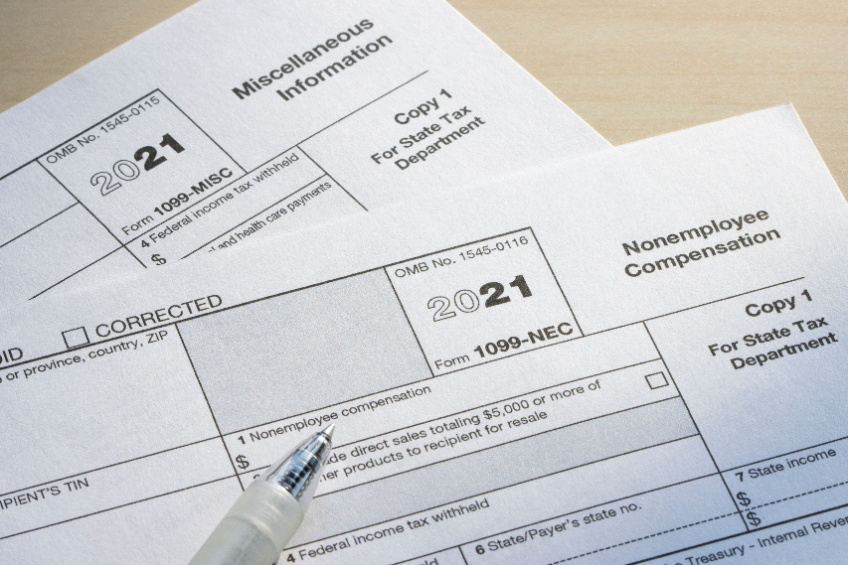Get to Know Form 1099, How Independent Contractors Talk to the IRS
Published:
Form 1099 is a tax form used to report income from independent contractors. It is sent to the contractor by the client and also to the IRS at the beginning of tax season every year. The form lists all payments made to the contractor during the prior tax year that exceed $600. This form helps in determining how much income the contractor has earned, as well as any applicable business expenses, self-employment taxes, social security taxes and other liabilities for which they may be responsible. Business owners should make sure that they receive their Form 1099s on time and submit them before filing their business tax returns or any other forms related to self-employment income. Failure to do so can result in hefty fines or even criminal charges for failure to comply with federal taxable income laws.
Self-Employed or Employee
When it comes to determining whether you are self-employed or an employee, the IRS generally looks at three factors: behavioral control, financial control and type of relationship. Behavioural control refers to the level of instruction given by the employer on how to perform certain tasks. Financial control refers to who has the authority over how much is paid for services rendered and when payments are made. Lastly, type of relationship looks at whether there is an expectation of continued work from both parties.
Self-employed individuals typically have more freedom in setting their own hours, determining their own work responsibilities and negotiating payment for services rendered. In contrast, employees are usually subject to a set schedule, specific job duties and fixed wages established by their employers. In addition, employees may also be eligible for certain benefits such as health insurance and vacation time that self-employed individuals do not receive. Ultimately, it is important to understand your employment status in order to ensure proper filing of taxes each year.
Who qualifies as an independent contractor?
An independent contractor is an individual or business that provides services to another person or company without being considered an employee of the other person or company. According to the IRS, independent contractors generally control their own schedule and working environment, set their own rates for services rendered, and are not subject to the instructions of their clients. They may also be eligible for certain deductions on their taxes, such as self-employment tax and business expenses. Independent contractors must file a Form 1099-MISC with the IRS each year to report any miscellaneous income they have earned from their contracts. Additionally, they must pay self-employment tax on their net earnings and file a Schedule C (Form 1040) to report all of their self-employment income and deductions. It is important for independent contractors to understand the filing requirements and deadlines associated with these forms in order to minimize potential tax liability.
Self-Employment and Taxes
Self-employment is a great way to be your own boss and have control over your work environment and income. However, it also means that you are responsible for filing all of the necessary paperwork with the IRS, which includes reporting any miscellaneous income that you receive from contracts on Form 1099-MISC. Additionally, as a self-employed worker, you must pay self-employment tax on your net earnings and file Schedule C (Form 1040) to report all of your self-employment income and deductions. It is important for independent contractors to understand the filing requirements and deadlines associated with these forms in order to minimize potential tax liability. By keeping organized records throughout the year and filing promptly by the due date, you can ensure that your taxes are filed correctly and on time.
Breaking down W-9 vs 1099 forms
The difference lies in what information the form reports and who’s responsible for filling it out. The worker fills out a W-9 form and gives it to the business, and it shows taxpayer information. This form is used for reporting contractor income to the IRS. On the other hand, a 1099-NEC form must be completed by the business and provided to both the independent contractor as well as to the IRS. This form reports nonemployee compensation paid out to contractors such as fees, commissions, prizes, awards or other payments during a fiscal year. It is important for independent contractors to understand these differences so that they can be sure their taxes are filed correctly and on time.
Tax deadline for Form 1099
It’s important for businesses and contractors to be aware of the tax deadline for Form 1099. All independent contractors should receive a copy of Form 1099-NEC, which must be completed by January 31st of the following year. This form is used to report nonemployee compensation such as fees, commissions, awards, or other payments given out during the fiscal year. Business owners are responsible for filing this form with the IRS and providing a copy to their contractor. If you fail to file the form by the deadline, you may face penalties from both state and federal authorities. It’s also important to remember that if there are any changes in your contractor’s income or other personal information throughout the year, it must be reported before the filing deadline as well. By staying informed about tax deadlines and ensuring that all paperwork is filed on time, businesses can avoid penalties and ensure their taxes are filed correctly.
Who uses the 1099 Form?
Filing a 1099 form is an important responsibility for both businesses and contractors. A 1099 form is used to report payments made to independent contractors, and it must be completed by January 31st of the following year. Businesses are required to provide a copy of Form 1099-NEC to their independent contractor and must also file this form with the IRS. If you have hired an independent contractor and paid them more than $600 in services, you are responsible for filling out this form. This also applies if the contractor has registered as a C corporation or S corporation. However, there is no need to fill out a form if the contractor has registered as a partnership or limited liability company (LLC). It’s important to remember that any changes in your contractor’s income or other personal information throughout the year must also be reported before filing time in order to avoid penalties from state and federal authorities. By staying informed about tax filing requirements and ensuring all paperwork is submitted correctly, businesses can ensure their taxes are filed properly and on time.
What are all the types of 1099 forms?
Form 1099 is an important tax form that reports income made by independent contractors. There are several types of 1099 forms, each one used to report a different type of payment. The most common form is the 1099-MISC, which is used to report non-employee compensation such as royalties, fees, rent, prizes and awards. Other forms include the 1099-A (Acquisition or Abandonment of Secured Property), 1099-C (Cancellation of Debt), 1099-DIV (Dividends and Distributions) and 1099-INT (Interest Income). All forms must be filed with the IRS by January 31st of the following year. It’s important to accurately fill out each form in order to avoid penalties from state and federal authorities. By staying informed about tax filing requirements and ensuring all paperwork is submitted correctly, businesses can ensure their taxes are filed properly and on time.
Which 1099s apply to the self-employed worker?
For self-employed contractors, filing taxes can be confusing. Knowing which 1099 forms to file is important in order to ensure accuracy and avoid costly penalties. The most common form is the 1099-MISC, which must be filed for any non-employee compensation received, such as rent, royalties, fees or prizes. Additionally, business owners should also file a 1099-NEC (Nonemployee Compensation) for each contractor they pay over $600 in a given year. Other applicable forms include the 1099-INT (Interest Income), 1099-A (Acquisition or Abandonment of Secured Property) and 1099-DIV (Dividends and Distributions). It’s important to file all necessary forms and submit them on time in order to stay compliant with tax regulations. By understanding which forms are applicable and when they must be filed by, self-employed workers can rest assured that their taxes are properly taken care of.
Which tax forms do subcontractors use?
Subcontractors are a vital part of many businesses, so it’s important to understand the tax forms they need to fill out. For any individual or business that pays an independent contractor more than $600 in a given year, the payer must file Form 1099-NEC (NonEmployee Compensation) with the IRS. This form can be filled out either electronically or on paper, but all forms must be filed by January 31st of the year following payment. In addition, subcontractors may also need to fill out other forms such as Form 1099-MISC (Miscellaneous Income) and Form 1099-INT (Interest Income), depending on the type of business they are working for. It’s important for both subcontractors and employers to understand their respective tax filing requirements in order to remain compliant with federal regulations.
Tax forms as a 1099 independent contractor
Filing taxes as a 1099 independent contractor is different than filing taxes for those who receive W-2 forms. As an independent contractor, you are responsible for paying your own taxes, including self-employment tax and social security. You must report all income earned, whether through 1099-NEC forms or other miscellaneous income. Additionally, any deductible business expenses may be used to reduce your taxable income. All of this information should be reported on your business tax returns.
As an independent contractor, it’s important to stay up to date with filing deadlines so that you don’t face any penalties or fines associated with late payment or filing. This means understanding the due dates associated with paper and electronic forms alike. For example, if you are using paper forms to file your taxes, they must be submitted by April 15th of the year following payment; however, if you are filing electronically, the deadline changes to March 31st of the same year. This is important for both contractors and businesses alike to understand in order to remain compliant with federal regulations regarding taxes and contract workers.



